Install and Configure Samba Server on Ubuntu 22.04/20.04 for File Sharing
In this tutorial, we’re going to learn how to install and configure a Samba server on Ubuntu 22.04/20.04 to share files on the local network. Samba is a free and open-source SMB/CIFS protocol implementation for Unix and Linux that allows for file and print sharing between Unix/Linux, Windows, and macOS machines in a local area network.
Samba is usually installed and run on Linux. It comprises several programs that serve different but related purposes, the most important two of which are:
- smbd: provides SMB/CIFS service (file sharing and printing), can also act as a Windows domain controller.
- nmbd: This daemon provides NetBIOS name service, listens for name-server requests. It also allows the Samba server to be found by other computers on the network.
How to Install Samba Server on Ubuntu
Samba is included in most Linux distributions. To install Samba on Ubuntu, simply run the following command in terminal.
sudo apt install samba samba-common-bin
The latest stable version available is 4.12.0, released on March 03, 2019. To check your Samba version, run
smbd --version
Sample output:
Version 4.7.6-Ubuntu
To check if Samba service is running, issue the following command.
systemctl status smbd nmbd
To start these two services, issue the following command:
sudo systemctl start smbd nmbd
Once started, smbd will be listening on TCP port 139 and 445. nmbd will be listening on UDP port 137 and 138.
- TCP 139: used for file and printer sharing and other operations.
- TCP 445: the NetBIOS-less CIFS port.
- UDP 137: used for NetBIOS network browsing.
- UDP 138: used for NetBIOS name service.
If you have enabled the UFW firewall on Ubuntu, then you need to open the above ports in the firewall with the following command.
sudo ufw allow samba
Create a Private Samba Share
In this section, we will see how to create a private Samba share that requires the client to enter username and password in order to gain access. The main Samba configuration file is located at: /etc/samba/smb.conf. You can edit it in terminal with a command line text editor like nano.
sudo nano /etc/samba/smb.conf
In the [global] section, make sure the value of workgroup is the same with the workgroup settings of Windows computers.
workgroup = WORKGROUP

You can find the setting on your Windows computer by going to Control Panel > System and Security > System.
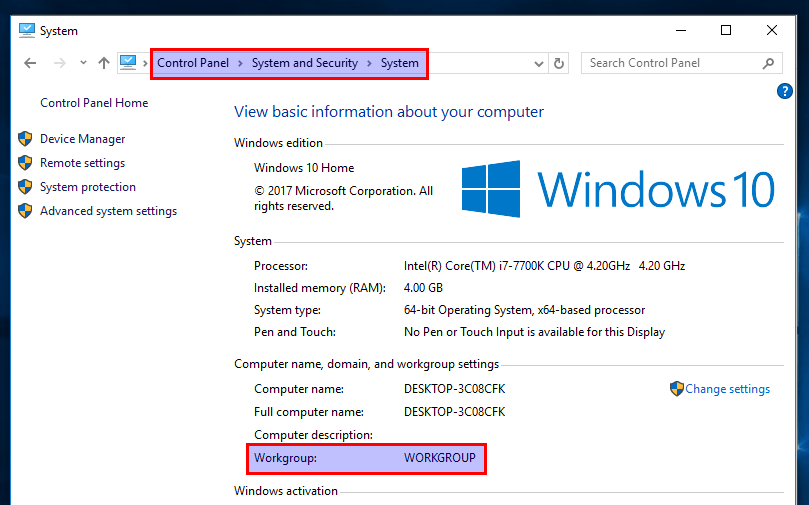
Then scroll down to the bottom of the file. (In nano text editor, you can achieve that by pressing CTRL+W then CTRL+V. ) Add a new section like below.
[Private] comment = needs username and password to access path = /srv/samba/private/ browseable = yes guest ok = no writable = yes valid users = @samba
Explanation:
Privateis the folder name that will be displayed on the Windows network.- The comment is a description for the shared folder.
- The path parameter specifies the path to the shared folder. I use
/srv/samba/private/as an example. You can also use a folder in your home directory. browseable = yes: Allow other computers in the network to see the Samba server and Samba share. If set to no, users have to know the name of the Samba server and then manually enter a path in the file manager to access the shared folder.guest ok = no: Disable guest access. In other words, you need to enter username and password on the client computer to access the shared folder.writable = yes: Grants both read and write permission to clients.valid users = @samba: Only users in the samba group are allowed to access this Samba share.
Save and close the file. (To save the file in nano text editor, press Ctrl+O, then press Enter to confirm the file name to write. To close the file, press Ctrl+X.) Now we need to create a Samba user. First, we need to create a standard Linux user account with the following command. Replace username with your desired username.
sudo adduser username
You will be prompted to set an Unix password. After that, you also need to set a separate Samba password for the new user with the following command:
sudo smbpasswd -a username
Create the samba group.
sudo groupadd samba
And add this user to the samba group.
sudo gpasswd -a username samba
Create the private share folder.
sudo mkdir -p /srv/samba/private/
The samba group needs to have read, write and execute permission on the shared folder. You can grant these permissions by executing the following command. (If your system doesn’t have the setfacl command, you need to install the acl package with sudo apt install acl.)
sudo setfacl -R -m "g:samba:rwx" /srv/samba/private/
Next, run the following command to check if there’s syntactic errors.
testparm
Now all left to do is to restart smbd and nmbd daemon.
sudo systemctl restart smbd nmbd
How to Create a Samba Public Share Without Authentication
To create a public share without requiring username and password, the following conditions must be met.
- Set
security = userin the global section of Samba configuration file. Although you can create a public share with thesecurity = sharemode, but this security mode is deprecated. It is strongly suggested that you avoidsharemode. - Set
map to guest = bad userin the global section of Samba configuration file. This will causesmbdto use a guest account to authenticate clients who don’t have registered account on the Samba server. Since it’s a guest account, Samba clients don’t need to enter password. - Set
guest ok = yesin the share definition to allow guest access. - Grant read, write and execute permission of the public folder to the
nobodyaccount, which is the default guest account.
As a matter of fact, the first two conditions are already met as Samba by default uses these two settings.
Here’s a step-by-step guide to create a public share. First, open and edit the Samba configuration file.
sudo nano /etc/samba/smb.conf
In the [global] section, make sure the value of workgroup is the same with the workgroup settings of Windows computers.
workgroup = WORKGROUP

You can find the setting on your Windows computer by going to Control Panel > System and Security > System.

Then scroll down to the bottom of the file and paste the following lines.
[public] comment = public share, no need to enter username and password path = /srv/samba/public/ browseable = yes writable = yes guest ok = yes
Save and close the file. Next, create the /srv/samba/public/ folder.
sudo mkdir -p /srv/samba/public
Then make sure the nobody account has read, write and execute permission on the public folder by executing the following command. (If your system doesn’t have the setfacl command, you need to install the acl package with sudo apt install acl.)
sudo setfacl -R -m "u:nobody:rwx" /srv/samba/public/
Restart smbd and nmbd.
sudo systemctl restart smbd nmbd
Accessing Samba Shared Folder From Windows
On a Windows computer that is in the same network, open File Explorer and click Network on the left pane. If you see the following message, then you need to click on the message and turn on network discovery and file sharing.
File sharing is turned off. Some network computers and devices might not be visible.
Next, enter \\ followed by the IP address of Samba server in the address bar of File Explorer, like this: \\192.168.0.102. You will see a list of shared resources on the Samba server.
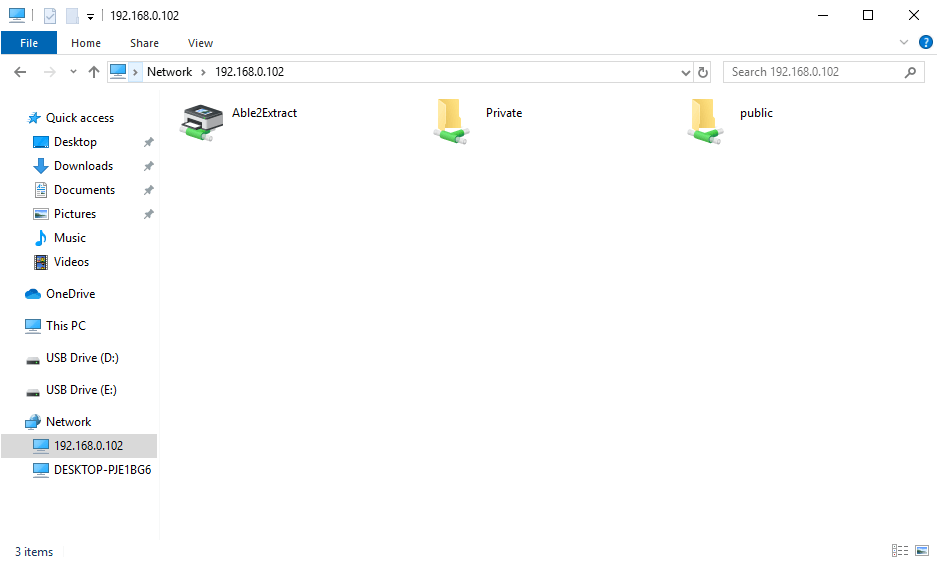
Then double-click the shared folder. To access the private share, you need to enter the samba username and password. You don’t need to do so to access public share.
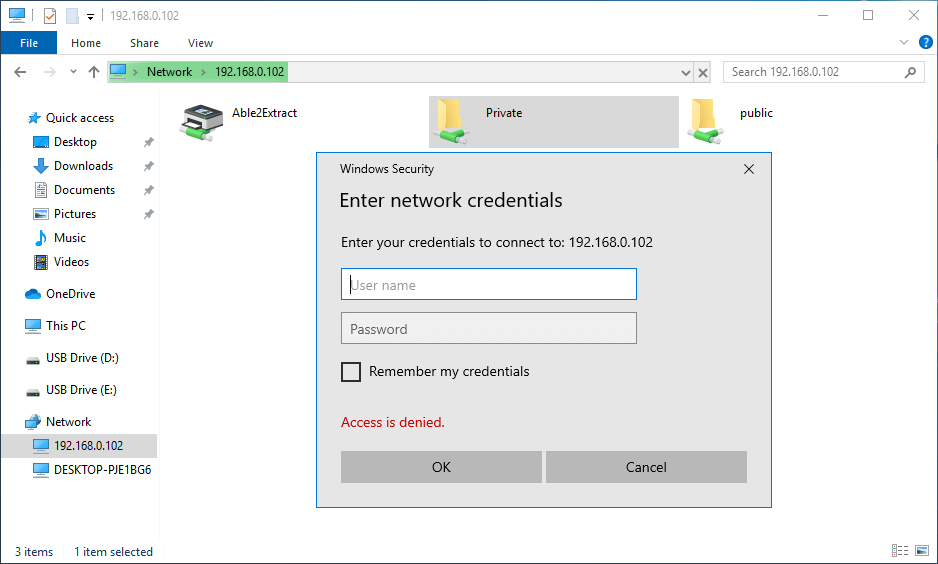
Once connected, you can read, write and delete files in the Samba shared folder.
Connecting Error
If you get the following error:
You do not have permission to access \\hostname\share-name. Contact your network administrator to request access.
You can try connecting to the Samba share from the command prompt. Open up a command prompt, then run the following command to close current Samba session.
net use \\samba-server-ip\share-name /delete
Next, connect to the Samba share with the following command:
net use \\samba-server-ip\share-name /user:samba-username password
Once the above command completed successfully, go to the Network tab in File Explorer and now you should be able to access the Samba share.
Drive Mapping on Windows
One feature of the Windows operating system is the capability to map a drive letter (such as S:) to a remote directory. To map the drive letter S: to the Samba share, right-click the Samba shared folder and select Map network drive. Then choose a drive letter and click Finish.
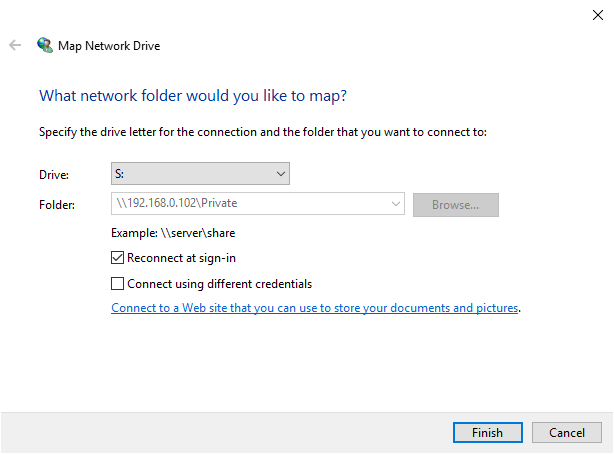
Once the drive mapping is established, applications can access the files in the Samba share through the drive letter S:. And this Samba share will be automatically mounted when you log in to your Windows computer.
Accessing Samba Share Folder in Nautilus File Manager on Linux
If you are using Nautilus file manager, then click Other Locations on the left pane. On the bottom, you will see an option to connect to server. To access your Samba share, type in smb:// followed by the IP address of the Samba server and press Enter. For example:
- smb://192.168.0.102
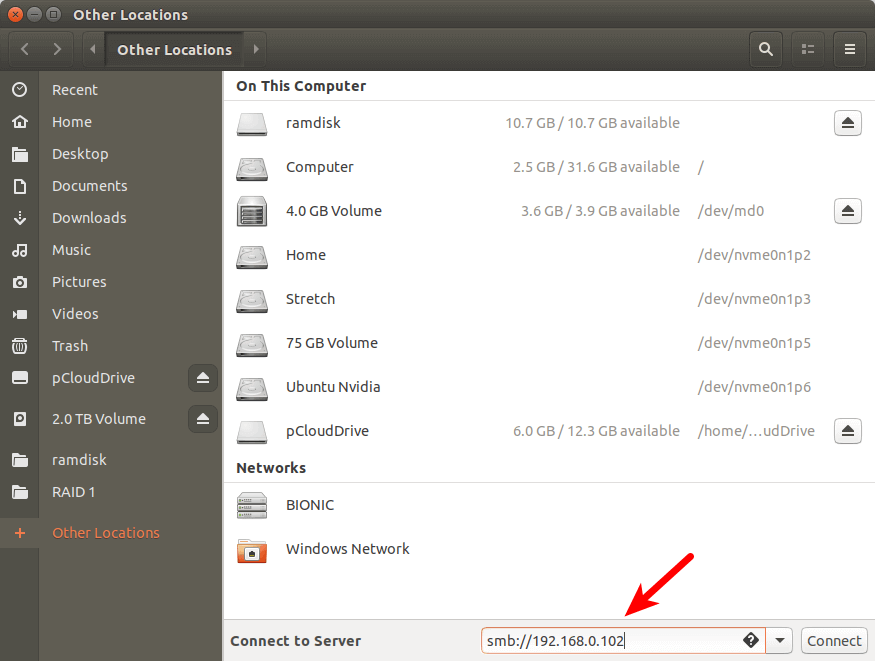
You will see a list of shared resources on the Samba server.
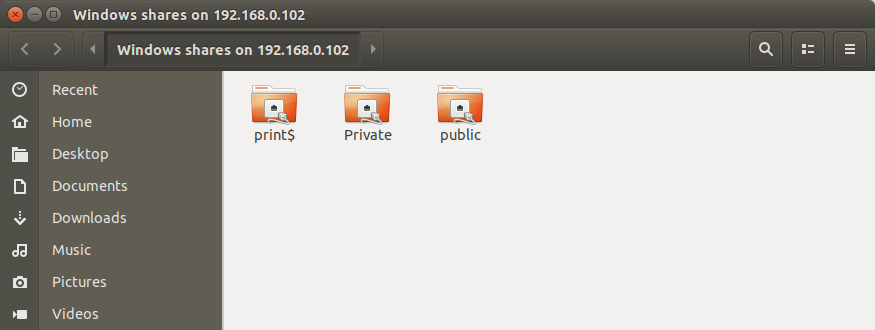
If you click the private shared folder, then you will need to enter the Samba username and password. If you click the public shared folder, then choose to connect as Anonymous.
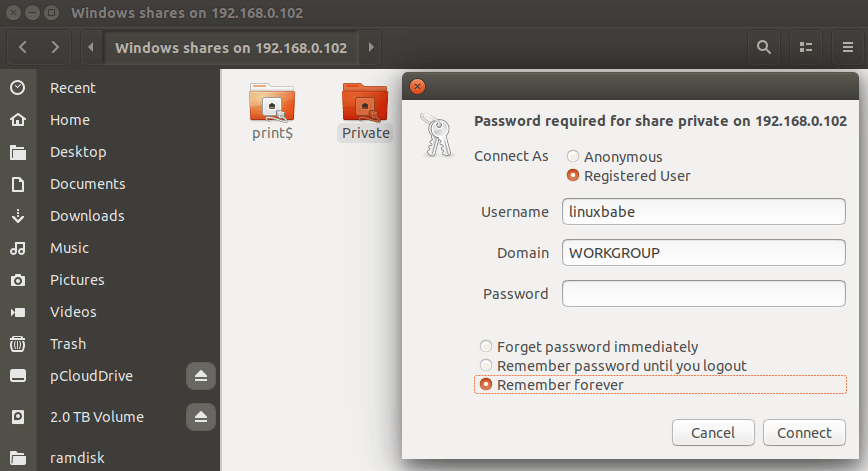
If you see the following error message,
failed to retrieve share list from server

You can try fixing this error by mounting the Samba share from the command line, which is discussed below.
Automatically Mount Samba Share From Command Line on Linux
Note: Automatically mounting the Samba share is done on clients. These commands should be run on a Samba client, if the Samba client runs Linux. You should not do it on the Samba server itself.
If you need to automatically mount the Samba share at boot time, you can use the command line to mount and then add an entry in the /etc/fstab file. In order to do that, you need to install the cifs-utils package.
CentOS/RHEL
sudo dnf install cifs-utils
Debian/Ubuntu
sudo apt install cifs-utils
Then create a mount point for the Samba share.
sudo mkdir /mnt/samba-private
Now you can use the following command to mount a private shared folder.
sudo mount -t cifs -o username=your_samba_username //192.168.0.102/private /mnt/samba-private/
It will ask you to enter the Samba password. After that, it will be mounted at /mnt/samba-private/ directory.
To automatically mount the Samba share, edit /etc/fstab file.
sudo nano /etc/fstab
Add the following line in the file.
//192.168.0.102/private /mnt/samba-private cifs x-systemd.automount,_netdev,credentials=/etc/samba-credential.conf,uid=1000,gid=1000,x-gvfs-show 0 0
Where:
- //192.168.0.102/private: the IP address of Samba server and the share name.
- /mnt/samba-private: mount point for the Samba share.
- cifs: filesystem type
- x-systemd.automount: This option tells systemd to create an automount unit for the file system. We use this because it ensures the remote filesystem is mounted only after there’s network access.
- _netdev: This specifies that the mount requires network.
- credentials=: Linux should look for credentials in the
/etc/samba-credential.conffile. - uid=1000,gid=1000: By default the mounted filesystem would be owned by the root user. We use uid and gid to change the ownership of the filesystem. Normally you use your own uid and gid, which are both 1000 by default.
- x-gvfs-show: If you are using GNOME desktop environment or its derivatives, you can use this option to show the mounted file system in the file manager.
Save and close the file. Then create the credential file.
sudo nano /etc/samba-credential.conf
Add the following lines in the file.
username=your_samba_username password=samba_password domain=WORKGROUP
Save and close the file. Make sure only the root user can read this file.
sudo chmod 600 /etc/samba-credential.conf
If you restart your Linux computer now, the Samba share will be automatically mounted. You can also run the following command to mount the Samba share without restart.
sudo mount -a
If you see the permission denied error and you can find the following line by running the sudo dmesg command,
VFS: cifs_mount failed w/return code = -13
it’s probably because you have a typo in the /etc/samba-credential file.
Further reading: How to Automount File Systems on Linux.
Can’t Write to the Samba Share?
The CIFS mount described above allows you to write to the Samba share. If you see the following error while creating a file:
Read-only file system
Check that you set writable = yes in the Samba configuration file. Sometimes, the Samba shared folder is on an external hard drive, then make sure you mount the external hard drive in read-write mode on the Samba server. For example, I mounted my btrfs hard drive with the following line in /etc/fstab.
LABEL=5TB /mnt/5TB btrfs defaults 0 0
It turns out that the defaults option doesn’t allow write operation. To make it writable, add rw option.
LABEL=5TB /mnt/5TB btrfs defaults,rw 0 0
Then unmount the hard drive. You need to use your own mount point.
sudo umount /mnt/5TB
And mount it again.
sudo mount -a
Troubleshooting Tip
If your Samba server is not working as expected, you can check the log files under /var/log/samba/ directory. You can add the following line in the [global] section of /etc/samba/smb.conf file to increase the log level if you want to log more information.
log level = 2
A Simple Trick to Boost Samba Performance
You can enable the TCP BBR algorithm to boost server network performance.
Wrapping Up
That’s it! I hope this tutorial helped you set up Samba server on Ubuntu. As always, if you found this post useful, then subscribe to our free newsletter. And you may also want to read the following article to share printer on the local network.
Want to run Samba over the Internet? You need to set up WireGuard VPN to encrypt the SMB/CIFS protocol. Since WireGuard uses peer-to-peer public-key authentication, it also allows you to remove password authentication in Samba, provided that you configure the firewall to allow Samba for VPN clients only and forbid all other IP addresses.
Want better performance? You can use NFS (Network File System) instead of Samba.



Thanks, nice work, as simple as it gets!
hvala
ni za kaj
Thnks a lot. Very useful tutorial
Perfect guide Thank you
Thank you! This was very easy to follow. I especially appreciate the detailed explanations on the steps!
Great how-to, only thing missing was: sudo apt-get install acl
Hi!
Installing from apt as described in this guide, Samba version available is Candidate: 2:4.7.6+dfsg~ubuntu-0ubuntu2.16.
How do you get a Samba version 4.X via apt?
Thank you!
This means you will have Samba 4.7.6.
Fabulous work. I could setup easily by following your article
I don’t have a workgroup but a domain instead, do I replace the ‘workgroup =’ with ‘domain =’?
Although I’ve done this before, I have to look it up every time. This is by far the easiest guide to follow. Thank you Xiao
Thank you for this Guide! Ubuntu 20.10 doesn’t have a Samba folder and i’m not even sure that Samba was even installed by default. The first section allowed me to install it and get a smb.conf to edit and add “client min protocol = NT1” to the [Global] section of the configuration file. Restarting the Samba Service now provides access to my old Dlink NAS and my backup files. I spent hours trying to rectify this issue and this article provided the info I needed. Bravo!
Thanks a lot for this guide
I would like to know a thing tho, since i really don’t know much about Linux.
The HDD where i have my share doesn’t automount on login. So is it correct that i first have to create an entry on fstab to automount the HDD, and then create a second on for the share?
Or is it enough to create for the share?
Thx a lot
Yes, you need to mount the HDD first in order to share it via Samba. You can read the following tutorial to learn how to automount a file system on Linux.
How To Automount File Systems on Linux
Thank you very much. I had already bookmarked the page you linked, because the tutorials are always so clear and awesome…. But wasn’t sure if one of the automounts made the other irrelevant 😉
Thx for clearing that up 🙂
The automount in the linked page is for the Samba server, so the Samba server can access your HDD at boot time.
The automount in this article is for Samba clients to automatically mount the Samba share.
hello again
so i am setting up my ubuntu system right now. i created the entries for my 3 hdd under /mnt/sda1….. sdb1….. sdc1 following your other guide. worked perfectly
now i want to create the samba share(s).
my question is: can i just create a samba share for /mnt, give rw access for all folders under /mnt.
Or do i have to create a share for every disc?
thank you very much
Forgot to add: if using “/mnt” i should put “/mnt/” as the path. correct?
Yes, you can create a single Samba share for the /mnt/ directory. Samba clients will be able to access all 3 HDDs.
thank you 🙂
almost at the finish line but testparm gives me an output that my netbios name is too long (max 15 characters).
with “smbclient -L ” i found out that my netbios name is “mmeiraserv-desktop”… which indeed is longer than 15 characters…
the question is how can i change this? is there any setting inside the smb.conf?
thanks
well… thats why some people shy away from linux: some things are called by different names 😛
thx a lot for the help. worked perfectly
another hickup:
i used “/mnt/” for the private smb share
my 3 hdds (and all the ones i will add later) should be part of the share
now in the automount instructions you created a new folder with “mkdir”
since i want to share all the content of the hdds, is this necessary for me?
or can i just set smb automount to “/mnt/”?
sorry i just dont know if it will conflict with the drive automounts
Which mkdir command are you referring to?
“sudo mkdir /mnt/samba-private”
so…i think the smb automount part broke everything…. cant access my automounted hard drives, and the smb share doesnt work either 🙁
this was the part that must have broke it:
“sudo mount -t cifs -o username=mmeirolas //192.168.1xx.xx/mmeiraserv /mnt/”
this is how my fstab file looks like:
UUID=0FD35A5456994A5C /mnt/sda1 ntfs defaults,rw 0 2
UUID=5A6EE0F06EE0C5BB /mnt/sdb1 ntfs defaults,rw 0 2
UUID=BE0A2BF70A2BAAFB /mnt/sdc1 ntfs defaults,rw 0 2
//192.168.1xx.xx/mmeiraserv /mnt/ cifs x-systemd.automount,_netdev,credentials=/etc/samba-credential.conf,uid=1000,gid=1000,x-gvfs-show 0 0
Automatically mounting the
Samba shareis done on clients.These commands should be run on a Samba client, if the Samba client runs Linux.
You should not do it on the Samba server itself.
Remove the /mnt/samba-private/ directory on the Samba server.
Remove the following line in /etc/fstab file on the Samba server.
thanks but i didnt create “/mnt/samba-private”…. i created just “/mnt/” because that is where the drives i want to share are…
now if i do “sudo rm /mnt/” i will break the automount of the drives right?
Then you don’t need to remove /mnt/samba-private/, nor /mnt/.
ok… it seemed to have worked. thanks 🙂
when i connect from my smartphone i can open the files on the share.
i can copy files from my smartphone to any of those 3 discs.
but when i try to move that file on my phone, from one disc to another it fails…
when i move the file on the server it works, but: that file doesnt show up on the phone. it is hidden and gives an error when try to open
“rw” is set in fstab
“setfacl” was used on the share
do u know what it could be?
I installed acl
There is a problem with the following process.
I got the message below.
~$ sudo setfacl -R -m “g:samba:rwx”/srv/samba/private/
setfacl: option -m: invalid argument near character 3
I want to know if I can get the same result through chmod.
My server is odroid hc2, a kind of SBC.
Type the command in the terminal, instead of copy and paste.
i created an admin user and also a user and cant find both users neither of those users can be seen even after restarting my smbd and nmbd. now i need to start the whole process all over again. kindly advise.
You need to create a standard Linux user account. Replace username with your desired username.
You will be prompted to set a Unix password. Then you also need to set a separate Samba password for the new user with the following command:
hi xiao, i have cp problems, can you help with suggestion?
i run this in client:
sudo cp /mnt/ckon/kon.bak /home/noob/test/
and got error message:
cp: cannot open ‘mnt/ckon/kon.bak’ for reading: Permission denied
server using lubuntu 20.04, client using lubuntu 18.04
I reverse the cp process:
sudo cp /home/noob/test/test.txt /mnt/ckon/
it’s succeed, i can see test.txt on both server and client
any insight where i might miss?
samba user in server is ckon, while login user in client is noob, is that might be the problem?
hello
I cannot connect because max connections = 0 if I check with testparm and got error message i exceeded the maximum connections
If I write into smb.conf file the max connection = 5 for example. does not work I still get max connection = 0 as testparm result
On slackware linux this is not issue works fine, on ubuntu I created samba but cannot connect because of this. how can i change max connections? editing smb.conf does not work. thanks
Thank you, this one worked with Windows 11 for me without 777 permissions
Finally! I searched so many forums trying to find a solution; I could not share to a Windows PC. And this is the ONLY place that suggested updating the “net” using command prompt on the WINDOWS machine!!!. Thank you! Thank you! Thank you!
This worked great except I can scan files from the printer into the public folder…but can’t delete them ;_;